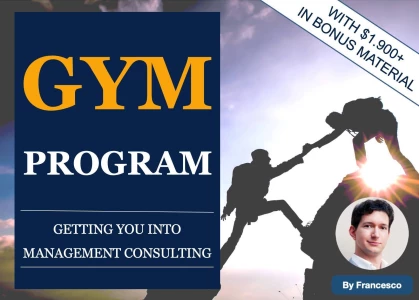Hi, I have an interview scheduled with Strategy& involving a 90minute written case interview. Can someone with past experience with S& please let me know how to prepare best and what to expect?
regards.
Hi, I have an interview scheduled with Strategy& involving a 90minute written case interview. Can someone with past experience with S& please let me know how to prepare best and what to expect?
regards.


Hi PD,
The key areas you will have to cover to prepare a written case are the following.
1. Learn how to define a plan of action and stick to that
The first thing you should do in a written case is to define a plan and allocate your time in the best possible way.
Assuming 60 minutes for the analysis (and then 30 to present), a good approach would include:
You should practice to stick to the time allocated to maximize your final performance.
2. Practice graph interpretation
You will probably have to analyze graphs as part of the data provided. The best way to practice is to take graphs from online sources and use a timer to test in how much time you can understand the key message. McKinsey PST graphs are good practice for that.
3. Work on quick reading and quick understanding of key information
You won’t have time to read and prioritize everything, therefore you have to understand where to focus. The ideal way to practice is to use long cases such as HBS ones. You should then learn to absorb the key information of the case. Quick reading techniques could also help.
4. Practice quick math
You will probably have some math to do as part of the data analysis. GMAT and McKinsey PST math should work well to prepare for this.
5. Learn how to communicate your slides/answers
When you have to present your findings in the second part, I would suggest the same structure used for a conclusion in a live interview, that is:
As you will not be able to double-check hypotheses with the interviewer while you prepare the presentation, you should clearly state when you are making hypotheses and that you will have to verify them with further analysis.
When you have to prepare slides I would also recommend to work on:
A) Structure the order of the slides
Normally the structure for a 5-slide presentation is the following:
B) Structure the content of each slide
There are three basic components for slides:
Many people structure the title as the mere description of what the chart is about.
A great title instead shows the implication of the graph as well.
Example: say the graph is showing a cost structure for a division.
The rule of thumb for the title is that if you read all the titles of the slides together you should get a clear idea of what is going on.
C) Present the slides
When you present, I would suggest the following steps for each slide:
If you want to prepare quickly and are short of time, I do a session exactly on that.
Before the session, I can send you the data source to work on. We can then simulate the presentation during the class, reviewing step-by-step all the improvements needed.
Please feel free to send me a message in case you have any questions.
Best,
Francesco

Hi PD,
First, good luck!
I recommend the following:
I have a number of written case I'd be more than happy to share with you! What I generally do with my candidates is, give them a written case x hours before our scheduled session (adjust # of hours based on the specific interview they're going to have), and then review their work during the session (as well as talk through tips+tricks to get better).
Other helpful Q&As
https://www.preplounge.com/en/consulting-forum/scenario-interview-presentation-prep-9325
https://www.preplounge.com/en/consulting-forum/how-to-practice-written-case-interviews-9199
https://www.preplounge.com/en/consulting-forum/case-interview-9228
https://www.preplounge.com/en/consulting-forum/how-to-practice-written-case-interviews-9199

Hi PD,
Here's my tips & advice for a long case with lots of data/information & 60mins prep time- thats the trend I have noticed with BIG4 in recent months
Please practice 2-3 written cases with a friend/peer/coach.
Good luck!

Hello!
Written case interviews are indeed becoming very fashionable nowadays as a way to interview!
Remember that the skillset tested is the same than in the "usual" cases, hence, all the practice you may have done totally plays in your favor.
One important point to add is the need to be very 80-20, structured and to the point, since the prep time is very short, so we need discipline with the analysis to have enaugh time to prep the communication strategy.
There are many many entries in thsi same Q&A regarding written cases, hence, I would recommend you to look with the keywords "written case"
Hope it helps!
Cheers,
Clara

Hi,
case preparation will be the classical one with 2 additional points to focus on:
I have a couple of well-done written cases, feel free to text me for sharing.
Best,
Antonello

Hi PD,
The good news is that by having solved the usual cases, you've already tackled one big chunk of the preparation! In theory, you just need to apply the technics you already know, + 80-20, plus time management, create a nice structure, and be correct in your math!
Hit me up if you have any further questions! Good luck with your interview;)
Cheers,
GB

